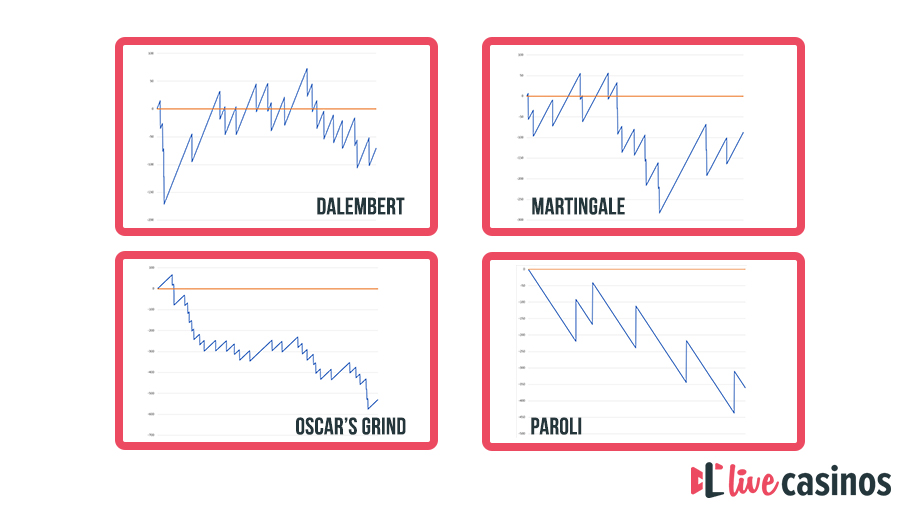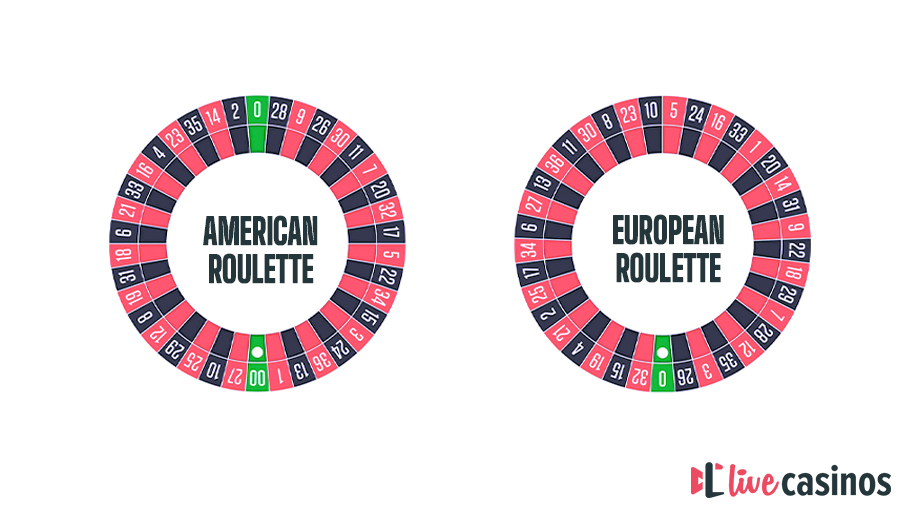Before we dive into some top roulette strategies, we have to define a few important terms.
These will help explain why certain strategies work and why they don’t. After all, many gambling strategies are unfortunately often based on ‘hoodoo’ – superstitions, misconceptions, or otherwise just a misunderstanding about how roulette works in terms of statistics and maths.
However, roulette works as a game because its odds and statistics are set up to always favor the house. There is no way to overcome this advantage because you can’t control where the ball will land.
However, players can still control the pace of the game and their betting, which is what’s used to form effective mathematical roulette strategies. We’ll explore some of these below and rate them in terms of expected value, variance, and risk of ruin.
- Expected Value – In mathematics, expected value is the mean average of a large number of independent, variable outcomes. It’s a sort of predicted outcome of a variable, based on the average probability of each outcome.
For example, every time you roll dice, there’s an equal chance that you’ll hit any result between 1 and 6. If we add those results up (21) and divide them by the number of possible outcomes (6), we get the average expected result of 3.5.
In gambling, expected value can also be described as the inverse of the house advantage. The higher the expected value of a bet compared to the stake, the lower its house edge, and vice versa.
- Variance – Otherwise known as volatility, this term defines how likely a bet is to win versus how much it pays. Broadly speaking, a more volatile bet is less likely to win but pays a higher reward when it does. A high variance might also mean that a bet simply has a high number of possible outcomes where only a few outcomes are highly faovrable. For example, a slot machine with a massive jackpot would be considered very volatile.
In terms of gambling, volatility is a matter of approach. Higher variance means less chance of success but higher rewards. Conversely, low variance might mean that the strategy can work even if you only bet a small number of times, but the rewards are not nearly as impressive.
- Risk of Ruin – In gambling, Risk of Ruin refers to the probability of losing your entire bankroll or reaching a point where further betting is impossible. This term is important seeing how some roulette strategies only work on paper because they assume that your bankroll is infinite and you can continue betting indefinitely. Since this is impossible in reality, players should keep the RoR in mind when picking a strategy.
Keep these terms in mind as we discuss these math-based roulette strategies and how applicable they are to real-life roulette sessions.
Popular Math-Based Betting Systems
Martingale – Basic Negative Progression
The Martingale is likely the most famous betting system out there. It’s based on a simple premise – if you double the stake on a 50/50 bet every time you lose, you’ll always be able to make back your losses.
While demonstrably effective, the Martingale has one glaring issue – its Risk of Ruin. If you keep increasing the stakes this quickly, you’re bound to either run out of money to wager or reach the maximum bet on the table. If this happens, you’ll be left without a bankroll.
The important thing to keep in mind with the Martingale is that doubling your wager means that the stake grows exponentially. A few consecutive losses can end up demanding massive investment, at which point the whole thing falls apart.
Broadly speaking, the chances of losing enough times to lose the Martingale are the same as roulette’s house edge – 2.7%. This illustrates why the Martingale does not allow you to overcome the house advantage.
Progression Rules:
- Play only 50/50 bets such as Red/Black
- Double the stake every time you lose, even on consecutive losses
- Once you win, revert to the original bet size
| Pros |
Cons |
| ✅ Effective at preventing losses
✅ Simple to use and benefit from
✅ Relies on low-variance bets, which can be considered safe |
❌ A few consecutive wins can completely drain your bankroll
❌ High Risk of Ruin
❌ Limits your betting to only Even Money bets |
Reverse Martingale (Paroli) – Streak Logic
As the name implies, the Paroli system is essentially a reverse version of the Martingale. It’s also based on even-money bets such as Red and Black.
The idea of Paroli is to double your stake every time you win, and do so up to 3 times in a row. Conversely, losing a bet means that you revert back to your original bet.
Fundamentally, the Paroli is a very different strategy from the Martingale. Where Martingale tries to protect you from losses, its reverse doubles down on wins and tries to take advantage of winning streaks.
The problem here is that streaks are impossible to predict, winning or otherwise. As such, losing the third bet in the progression will completely negate any profits.
However, hitting a string of consecutive losses is not nearly as damaging as with a negative progression system like the Martingale.
Progression Rules:
- Play only 50/50 bets such as Red/Black
- Double the stake every time you win, up to 3 times in a row
- If you lose a bet, revert to the original bet
- Once you win three bets in a row, revert to the original bet size
| Pros |
Cons |
| ✅ Good for maintaining a stable bankroll
✅ Simple to use and benefit from
✅ A 3-win streak results in solid winnings and isn’t too hard to achieve |
❌ Relies on winning streaks, which are impossible to predict
❌ Limits your betting to only Even Money bets |
D’Alembert – Linear Progression
The D’Alembert system is a negative progression betting strategy, meaning you increase your stake after a loss and decrease it after a win.
The idea is that wins and losses should eventually even out – and if they do, you’ll come out ahead because your wins will have been at slightly higher stakes.
Unlike the Martingale, however, the D’Alembert is not nearly as aggressive. Instead of increasing exponentially, stakes grow linearly. This means that you increase it by +1 unit after every loss instead of doubling it.
The result is a safer but less effective Martingale. For starters, its not “guaranteed” to make up losses like the Martingale, since a losing streak will mean that your losses outpace your winnings. However, it’s also not nearly as prone to Ruin since bets during losing streaks increase at a much lower rate.
Progression Rules:
- Play only 50/50 bets such as Red/Black
- Split your bankroll into equal Units
- Start by betting 1 unit on an Even Money bet
- If you lose, increase the stake size by +1 unit. (e.g. 4 lost bets in a row would bet 1, 2, 3, and 4 units, respectively)
- If you win, decrease the stake size by -1 unit
- If the bet size is already at 1 unit, it stays the same
| Pros |
Cons |
| ✅ Good for maintaining a stable bankroll
✅ Relatively non-volatile, allowing for more time at the table
✅ Benefits from winning streaks while protecting your bankroll from losing streaks, though to a lesser degree than other systems |
❌ Low chance of actually winning in the long run due to the soft progression curve
❌ Limits your betting to only Even Money bets |
Fibonacci – Sequence Growth
Named after the famed Fibonacci Sequence, the Fibonacci strategy is a negative progression betting system that increases stakes based on a specific number sequence.
The system was devised as a sort of ‘middle ground’ between the Martingale and the D’Alembert. It’s less volatile than the former, but has a higher chance of coming out on top than the latter.
To understand the strategy, we first have to understand the number sequence.
The Fibonacci sequence is a string of numbers in which every number is the sum of the previous two. As such, the first 10 numbers in the sequence are:
1, 1, 2, 3, 5, 8, 13, 21, 34, 55
As such, the progression curve is not quite exponential, but not quite linear either. To use this system, simply follow the steps outlined below.
Progression Rules:
- Play only 50/50 bets such as Red/Black
- Split your bankroll into equal units
- Start by betting 1 unit as the second number in the Fibonacci sequence
- If your bet wins, go back two numbers in the sequence. For instance, if you bet 5 units and win, you should bet 2 units in the next round.
- If your bet loses, move up one number in the sequence. For instance, if you bet 2 units and lose, you should bet 3 units in the next round.
- If you win and fall off the sequence (i.e. go below 1), revert to the initial stake size.
| Pros |
Cons |
| ✅ Stays flat and non-volatile after a win, which makes it easier to end the system and walk off with a profit
✅ Can quickly make up any losses, provided you don’t hit a long losing streak
✅ Solid middle-ground between volatile progression systems and safer strategies |
❌ Tends to result in ‘pushes’ – you don’t lose anything, but you don’t win much either
❌ A long losing streak can still be disastrous, but it’s less of an issue than with the Martingale |
Oscar’s Grind – Linear Positive Progression
The Oscar’s Grind strategy is a positive progression system with a flat curve. In other words, it increases the stakes after a win by a flat amount instead of an exponential one.
Essentially, Oscar’s Grind is a reversed D’Alembert. It’s based on raising stakes by a fixed amount every time you win with the goal of benefiting from winning streaks.
As such, a loss after multiple wins can set you back quite a lot. However, this is not nearly as much of an issue as with the D’Alembert, since you’ll only lose a part of what you managed to win up to that point.
On the flip side, this also means that you don’t benefit as much from winning streaks, so it’s harder to achieve your profit goals.
Progression Rules:
- Play only 50/50 bets such as Red/Black
- Split your bankroll into equal Units
- Set a clear winning goal. For example, a profit of 10 units.
- Start by betting 1 unit on an Even Money bet
- If you lose, repeat the same bet as the one you lost
- If you win, increase the stake by +1 unit and repeat the bet.
- Repeat these steps until you hit the winning goal or run out of money
| Pros |
Cons |
| ✅ Benefits from winning streaks without increasing stakes too rapidly
✅ Keeps the variance manageable while still striving to achieve a clear goal
✅ The fact that you don’t revert back to the start after a loss means that you’re somewhat protected from losses |
❌ Even a short losing streak can set you back multiple steps, making it impossible to win back your losses
❌ Unless you’re lucky, you’re likely to simply not win or lose, staying at a sort of net zero. |
Simulation Results & Data-Driven Insights
To showcase how these mathematical roulette strategies work in practice, here are the results of several of these betting systems over a 100-round simulation.
The charts show what your bankroll is likely to look like as you use the systems, comparing the Martingale, Paroli, D’Alembert, and Oscar’s Grind.

Importantly, note that the systems still result in a net loss, given a long enough time frame. This emphasises the fact that no strategy can truly overcome the house advantage of roulette. However, there are still points at which the player is at a net profit. The idea is to ‘know when to quit’ – if your system results in a profit, it’s usually best to stop playing.
The ‘Optimal’ Practical Approach
The house advantage of roulette remains 2.70% no matter which bet you’re making and how you’re making it. With that in mind, betting systems are largely bankroll management tools and not a sure-fire way to win.
With that in mind, there’s one more approach that can work just as well – flat betting. Flat betting simply means that you bet the same amount on the same bet in every round.
While flat betting doesn’t negate losses or benefit from winning streaks, it has the advantage of consistency. Statistically speaking, it does not have any disadvantages compared to any other structured betting system.
While roulette math tricks won’t give you a statistical advantage, there are still ways to minimize the house advantage of roulette:
- Never, ever play on American roulette wheels. They are strictly worse than European variants and offer worse odds with no redeeming qualities.
- Try French Roulette tables, if you can find them. French roulette introduces special rules that essentially halve the house advantage of Even Money bets. This brings their RTP up to 98.65% provided you’re only making Even Money bets.










































 Roulette
Roulette
 Blackjack
Blackjack
 Baccarat
Baccarat
 Poker
Poker
 Sic Bo
Sic Bo
 Dragon Tiger
Dragon Tiger
 Game Shows
Game Shows  Top 5 Games
Top 5 Games  See more
See more  Roulette Casinos
Roulette Casinos  Low Limit
Low Limit  High Limit / VIP
High Limit / VIP  Exclusive
Exclusive  How to Play
How to Play  Basic Strategy
Basic Strategy  Top Tips
Top Tips  FAQ
FAQ  Blackjack Casinos
Blackjack Casinos  Baccarat Casinos
Baccarat Casinos  Bonuses
Bonuses  Poker Casinos
Poker Casinos  Game Providers
Game Providers  Sic Bo Casinos
Sic Bo Casinos  Dragon Tiger Casinos
Dragon Tiger Casinos  Credit and Debit Card
Credit and Debit Card  e-Wallet
e-Wallet  Cryptocurrency
Cryptocurrency  Bank and Checks
Bank and Checks  Pay by Phone and SMS
Pay by Phone and SMS  See more
See more  How-To Guides
How-To Guides  Top Lists
Top Lists  In-Depth
In-Depth  Strategy
Strategy  Casino & Games
Casino & Games  Insight
Insight  News
News  Promotions
Promotions 
 Guide to Live Casinos
Guide to Live Casinos  Top 10 Live Casino Tips
Top 10 Live Casino Tips  Studio Locations
Studio Locations  FAQ & Help
FAQ & Help  Meet The Dealers
Meet The Dealers  Our Awards
Our Awards  How We Rate
How We Rate  Responsible Gambling
Responsible Gambling 




























 ENG
ENG 







 Facebook
Facebook
 Pinterest
Pinterest
 Twitter
Twitter
 LinkedIn
LinkedIn
 Copy Link
Copy Link 


















